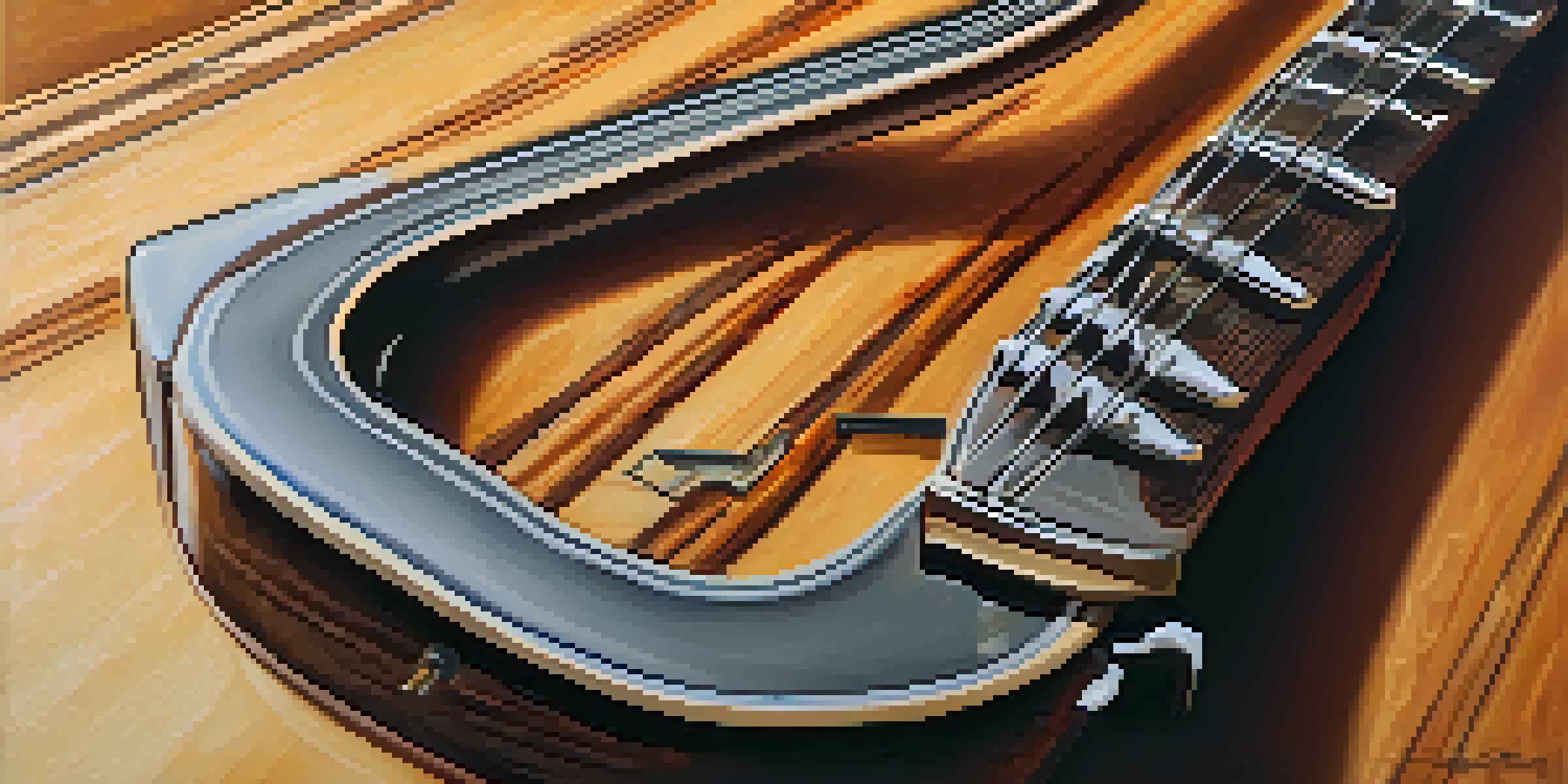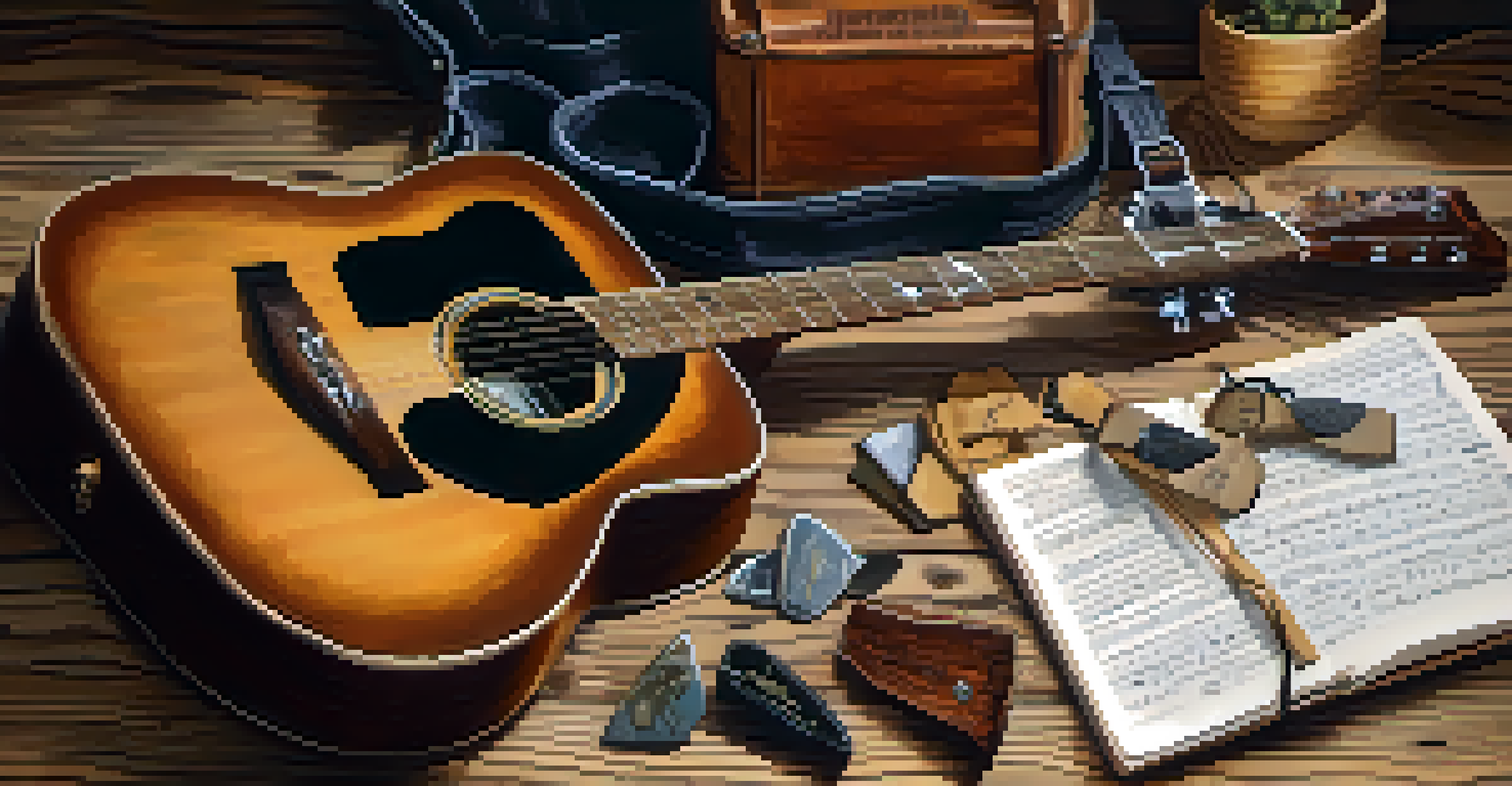Using Capo for Vocal-Friendly Guitar Chord Arrangements

What is a Capo and How Does It Work?
A capo is a simple yet powerful tool that clamps onto the neck of your guitar, allowing you to change the pitch of the strings without altering finger positions. Think of it like a musical cheat sheet, enabling you to play in different keys easily. By using a capo, you can hit higher notes while still using familiar chord shapes.
Music is the shorthand of emotion.
This means you don’t have to learn new fingerings for every key; instead, you can shift all your chords up the neck. For example, placing a capo on the second fret will raise all your chords by two half steps. This is especially handy for vocalists who need to adjust the song’s key to match their range.
Overall, a capo opens up a world of possibilities, making it easier for guitarists to accompany their singing without feeling overwhelmed. Whether you're a beginner or a seasoned player, understanding how to use a capo is a game changer for creating vocal-friendly arrangements.
Choosing the Right Key for Your Voice
One of the most important aspects of using a capo is selecting the right key for your vocal range. Everyone’s voice is unique, and what works for one singer might not work for another. By experimenting with different capo placements, you can find a key that feels comfortable and allows your voice to shine.

For instance, if a song is too low and you struggle to hit the notes, try moving the capo up a few frets. This simple adjustment can make the world of difference, allowing you to sing with confidence. Conversely, if a song feels too high, you can move the capo down to find a more suitable range.
Capos Simplify Key Changes
A capo helps guitarists change the key of a song without learning new chord shapes, making it easier to match vocal ranges.
Take the time to play around with various positions, and don’t be afraid to record yourself. Listening back can provide insight into what works best for your voice, helping you choose the perfect key each time.
Using a Capo for Simpler Chord Shapes
One of the best benefits of using a capo is that it allows you to play simpler chord shapes while still achieving a professional sound. Many songs can be complex, with challenging barre chords that can be tough for beginners. A capo can help you avoid these difficulties by letting you play open chords instead.
The beauty of music is that it transcends language.
For example, if a song in E minor requires a barre chord, placing a capo on the second fret can turn it into a D minor, which is much easier to play. This way, you maintain the song's original feel and tone without straining your fingers. It's like having the best of both worlds: ease of play and a great sound.
This makes the capo an invaluable tool for beginners who want to sound good without getting bogged down by difficult chords. It encourages practice and exploration, helping you build confidence as you progress musically.
Enhancing Your Songwriting with a Capo
Using a capo can also spark creativity when you're writing songs. By shifting your chords to different keys, you can discover new melodies and progressions that inspire you. This exploration can lead to unique sounds that you might not have stumbled upon otherwise.
For instance, if you’re stuck in a songwriting rut, try placing your capo in various positions and play around with different chord combinations. You might find that a simple change in key breathes new life into your ideas. It's a fantastic way to step outside your usual patterns and experiment with your sound.
Enhancing Creativity with Capos
Using a capo can inspire new melodies and progressions, allowing songwriters to explore fresh musical ideas.
Additionally, many well-known songwriters have used capos to create their signature sounds. Emulating their techniques and styles can enrich your own songwriting process, giving you fresh perspectives and innovative ideas.
Common Mistakes When Using a Capo
While using a capo is straightforward, there are some common mistakes that guitarists often make. One of the biggest blunders is placing the capo incorrectly, which can throw off your tuning and give your chords a muddled sound. Always ensure the capo is positioned right behind the fret wire for the best results.
Another mistake is assuming that a capo can completely replace good technique. While it makes certain aspects easier, it’s essential to continue developing your finger strength and chord knowledge. Relying solely on a capo can limit your growth as a guitarist over time.
Lastly, some players forget to adjust their strumming patterns when using a capo. Different keys can require different dynamics, so pay attention to how the capo alters the song’s feel. Being mindful of these elements can help you avoid pitfalls and enhance your overall performance.
Capo Techniques for Advanced Players
For more advanced players, a capo can be used creatively to add depth and texture to your playing. Techniques like partial capos or using the capo on different frets can create interesting voicings and unusual chord shapes. This opens up a whole new world of sounds that can elevate your music.
For instance, using a partial capo can allow you to play open strings while fretting others, creating unique harmonies. This technique can produce beautiful effects, giving your music a distinctive flair. It’s a great way to experiment and discover new dimensions in your sound.
Common Capo Mistakes to Avoid
Proper placement and technique are crucial when using a capo to ensure clarity in sound and to enhance overall performance.
Moreover, combining a capo with fingerstyle or alternate tunings can yield even more innovative results. Embrace the challenge, and let your creativity flow as you explore the endless possibilities that a capo has to offer.
Conclusion: The Capo’s Versatile Role in Music
In conclusion, a capo is an invaluable tool for both beginners and advanced guitarists. Its ability to simplify chord arrangements and accommodate vocal ranges makes it a go-to accessory for many musicians. By understanding how to use a capo effectively, you can enhance your playing and singing experience.
Whether you're strumming along to your favorite songs or crafting your own melodies, the capo allows you to explore different keys and sounds with ease. It's not just a tool; it’s a gateway to creativity and expression in your music.

So grab your capo, experiment with different placements, and discover how it can transform your guitar playing and singing. With a little practice, you'll be well on your way to creating beautiful, vocal-friendly arrangements!